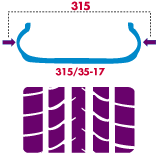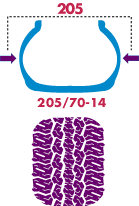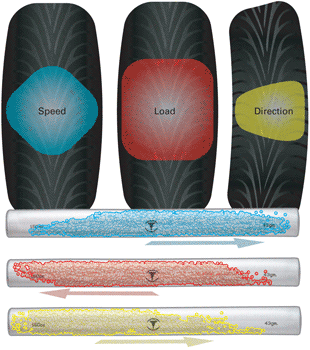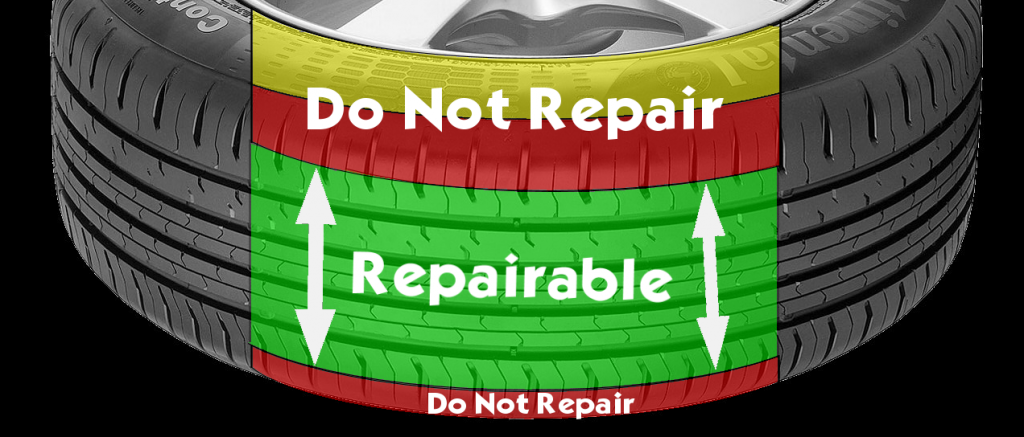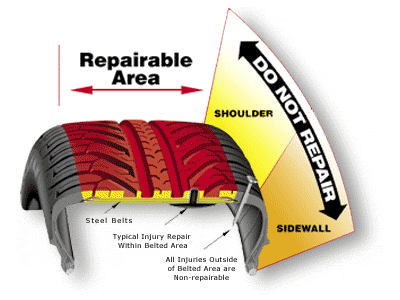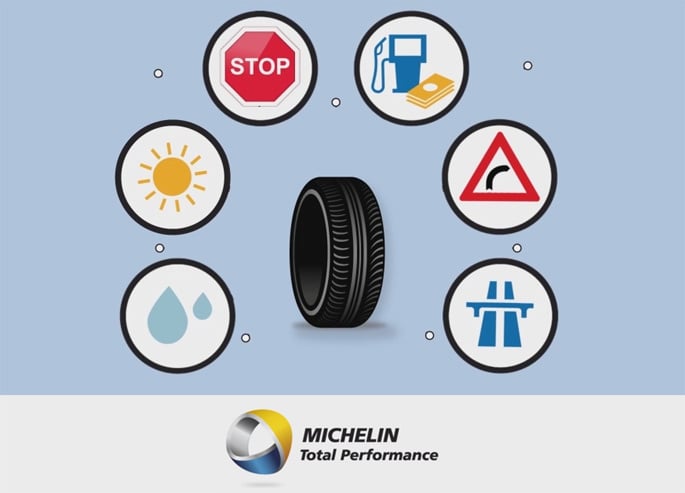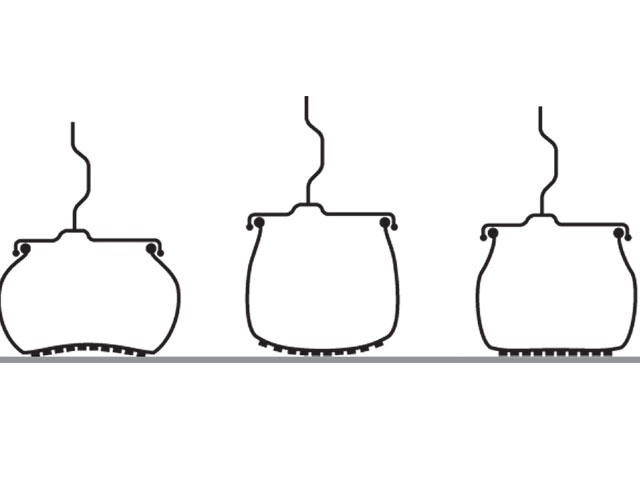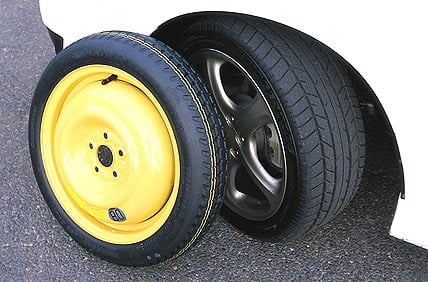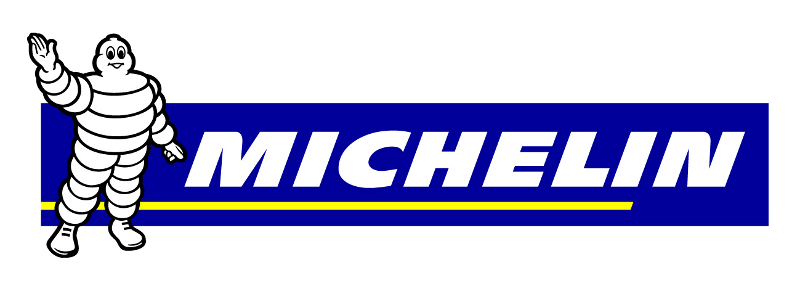Selecting the right tires for your vehicle is an important decision. Your safety, as well as driving enjoyment over the next years and thousands of miles will be determined by this decision. The information provided here and the advice/recommendations from the experts at the Tire Rack will ensure you select tires that match your vehicle...and the way you drive it!
How Many Tires Do I Need?
Since tires affect the personality and performance of your vehicle, all four tires should be as identical as possible or handling problems may arise. If your tires don't match, it is possible that one end of your vehicle won't respond as quickly or completely as the other, making it more difficult to control.
Consider the Following:
Just One Tire?
If your tires have a lot of remaining tread depth, but you need to replace just one that has been damaged by an accident, road hazard or a vandal, you should replace it with a tire that exactly matches the others. Select a replacement tire of the same brand, line, size and speed rating. While there may be a less expensive tire available, it wouldn't be a bargain this time because it would be different than the other three tires on your vehicle.
A Pair of Tires?
If two of your tires have a lot of remaining tread depth, but you need to replace the other two because they were damaged or have worn out, you should replace them with a pair of tires that come as close as possible to matching your existing tires. While identical new tires are desirable, others of the same size and type can also provide good results. Only consider selecting new tires that are from the same tire category as your existing tires. New tires should be installed on the rear axle.
While your vehicle is being serviced ask your mechanic why one pair of tires have worn faster than the others. Was it caused by a lack of tire rotation, out-of-spec wheel alignment or loose mechanical parts? Once the problem has been found, it can be corrected before it damages your new tires. Keep in mind that your ultimate goal is that all of your tires always wear out at the same time so they can be replaced as a set.
A Set of Tires?
If all of your tires are wearing out together, you have the greatest flexibility in tire selection. If you were happy with the original tires, simply replace them. If you want longer treadwear, a smoother ride or more handling, there are probably tires that will help you accomplish that. Review the tire category types until you find a category description that describes a tire that fits your needs.
Once you know how many tires you will be replacing, determine size and type by answering the questions below:
What Is the Right Size for My Vehicle?
Buying the correct tire size can get complicated, especially if you decide to upgrade from your vehicle's Original Equipment size. The expert sales team at the Tire Rack is always ready to offer performance and fitment advice. Call 888-541-1777.
A tire's first requirement is that it must be able to carry the weight of your vehicle. No matter how good a tire you select, if its capabilities are "overworked" just carrying the load, it will have little reserve capacity to help your vehicle respond to a quick emergency. So when you are in the selection process, make certain that your new tire's size is designed to carry the weight of your vehicle! Don't undersize.
The other size consideration is overall tire diameter. Since many of the functions of today's vehicles are highly computerized, maintaining accurate speed data going into the computer assures accurate instructions coming out. And an important part of the speed equation is your tire's overall tire diameter.
For cars and vans, staying within a 3% diameter change is desirable. Pick-ups and sport utility vehicles (SUVs) are usually engineered to handle up to a 15% oversize tire. Most tire dimensions can be calculated. For more information review the Tire Tech article, "Calculating Tire Dimensions." While at first a 3% diameter increase or reduction in tire diameter may sound very limiting, in most cases it allows approximately a 3/4" diameter change.
Additionally to help with the selection of substitute sizes, a system called "Plus Sizing" was developed. We use Plus Sizing to take into account the diameters of the available tires and the wheels, and then helps select the appropriate tire width that ensures adequate load capacity. Maintaining the tire's overall diameter helps maintain accurate speed data going into the computer.
Do I Need Summer Tires, Winter Tires, All-Season Tires?
Do you drive your car only in sunshine, or also through rain and snow? Do you drive your light truck on the road, off the road, or are you the one responsible for clearing the land to build the roads? To successfully meet each of these driving conditions requires a different type of tire.
Ask yourself these questions to determine which performance category you should choose from:
What Is the Worst Driving Condition I Will Encounter?
If you use more than one set of tires and wheels (for example, summer tires in summer and snow tires in winter), you can select tires that exactly meet your diverse needs. If you use one set of tires for every season, you may get good performance under many conditions, but you will compromise your vehicle's performance when the conditions are at their worst.
So the important thing to do is to select your tires so that they match the worst driving condition you expect to encounter. When you're stuck in the snow or in the mud because your tires don't have the appropriate capabilities, you'll curse their limited performance in your worst driving condition...and you'll quickly forget how smooth and quiet they were at other times!
What Are the Typical Driving Conditions I Will Encounter?
If you only drive around your neighborhood and a "long trip" is one that's just down to the corner convenience mart, almost any tire will do. But if you drive your vehicle on congested city streets and expressways during rush hour you will be better served by more responsive tires. If you drive extensively on the interstates you will want quiet, smooth riding, long wearing tires. Or if you like to drive quickly on twisting roads or through the mountains you will want good handling tires. And if you drive on the track or in autocross events, you will want the best competition tires available.
Balancing the Requirements of Your Driving Conditions
If your worst driving conditions and your typical conditions are similar, one set of tires will be all you need. If you live at the edge of the snowbelt and infrequently get snow you may want to select an all-season tire. If your SUV is used as the family's station wagon and driven on the road all of the time, overly aggressive light truck tires aren't for you (unless you really like the "look").
If your worst driving condition occurs frequently (you drive through snow all winter) and is dissimilar to your typical driving condition (you commute to work on the expressway during the week and spend your weekends at the beach), you may want to consider selecting two sets of tires for your vehicle. Each set will be designed to master the specific conditions without compromising your driving satisfaction at the extremes. While purchasing two sets of tires may appear expensive, the set you're not using won't wear while you are using the other set, and combined they'll provide longer total wear than either set could individually!
How Do I Compare Price Vs. Value?
Why is it that the price of fuel for our vehicle seems relatively inexpensive while the cost of tires seems high? (Of course you already know that the Tire Rack tries to keep your tire costs as low as possible!) If we keep track of our total costs we will find that typical total fuel costs for just 10 to 20 thousand miles of driving actually exceed our tire costs. And believe us, we've found that the quality and performance of our tires has a lot more to do with our driving satisfaction than our fuel does.
We think that much of the misperception has to do with the fact that we buy fuel one tankful at a time, and don't really look at its total cost for thousands of miles. Our tires are paid for "up front" and then last for tens of thousands of miles.
When you are selecting new tires and find one that is perfect, although more expensive than another tire that appears to be a close second, consider evaluating your situation by comparing "how much per mile" each tire will cost. If you plan to drive your vehicle another 30,000 miles and are considering the "perfect" tires at $100 each, and the other at $90 each; you may be surprised to find out that the cost of the "perfect" set costs just 1.3 cents per mile...while the close set costs 1.2 cents per mile. Will saving the $40 today make up for not having selected the "perfect" tire that you will be driving on for the next two years?
The Law
According to most states' laws, tires are legally worn out when they have worn down to 2/32" of remaining tread depth. To help warn drivers that their tires have reached that point, tires sold in North America are required to have molded indicators called "wear bars" across their tread pattern from their outside shoulder to inside shoulder. Wear bars are designed to visually connect the elements of the tire's tread pattern and warn drivers when their tires no longer meet minimum tread depth requirements.
Common Sense
However, as a tire wears it is important to realize that while its dry traction and handling will improve its ability to perform in rain and snow will diminish. At 2/32" of remaining tread depth, resistance to hydroplaning in the rain at highway speeds has been significantly reduced and traction in heavy snow has been virtually eliminated.
If rain and wet roads are a concern, you should consider replacing your tires when they reach approximately 4/32" of remaining tread depth. Since water can't be compressed, you need enough tread depth to allow it to escape through the tire's grooves. If the water can't escape fast enough your vehicle's tires will be forced to hydroplane (actually float) on top of the water, loosing traction.
If snow covered roads are a concern, you should consider replacing your tires when they reach approximately 5/32" of remaining tread depth to maintain good mobility. The reason that you need more tread depth in snow is because your tires need to compress the snow in their grooves and release it as they roll. If there isn't enough tread depth, the "bites" of snow your tires can take on each revolution will be so small that your traction will be reduced. Because tread depth is an important element for snow traction, winter tires start with deeper tread depths than standard all-season or summer tires. Some winter tires even have a series of wear bars molded in their tread pattern indicating approximately 6/32" remaining tread depth.


